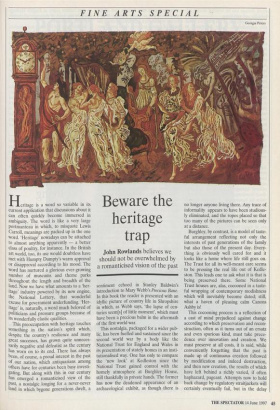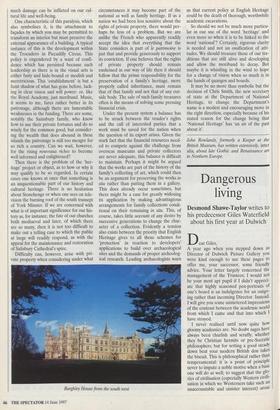FINE ARTS SPECIAL
Georgia Peters
Beware the heritage trap
John Rowlands believes we should not be overwhelmed by a romanticised vision of the past Heritage is a word so variable in its current application that discussions about it can often quickly become immersed in ambiguity. The word is like a very large portmanteau in which, to misquote Lewis Carroll, meanings are packed up in the one word. 'Heritage' nowadays can be attached to almost anything apparently — a better class of poultry, for instance. In the British art world, too, its use would doubtless have met with Humpty Dumpty's warm approval or disapproval according to his mood. The word has nurtured a glorious ever-growing number of museums and theme parks throughout the length and breadth of the land. Now we have what amounts to a 'her- itage' industry powered by its new engine, the National Lottery, that wonderful excuse for government underfunding. 'Her- itage' is, naturally, a word much beloved of politicians and pressure groups because of its wonderfully elastic qualities. This preoccupation with heritage touches something in the nation's spirit which, despite the country's resilience and many great successes, has grown quite unneces- sarily negative and defeatist as the century has worn on to its end. There has always been, of course, a proud interest in the past of our nation, which antiquarians among others have for centuries been busy investi- gating. But along with this in our century has emerged a romanticised view of the past, a nostalgic longing for a never-never land in which bygone generations dwelt, a sentiment echoed in Stanley Baldwin's introduction to Mary Webb's Precious Bane. In this book the reader is presented with an idyllic picture of country life in Shropshire in which, as Webb says, 'the lapse of cen- turies seem[s] of little moment', which must have been a precious balm in the aftermath of the first world war. This nostalgia, packaged for a wider pub- lic, has been fuelled and sustained since the second world war by a body like the National Trust for England and Wales in its presentation of stately homes in an insti- tutionalised way. One has only to compare the 'new look' at Kedleston since the National Trust gained control with the homely atmosphere at Burghley House, still thankfully in private hands. The former has now the deadened appearance of an archaeological exhibit, as though there is no longer anyone living there. Any trace of informality appears to have been studious- ly eliminated, and the ropes placed so that too many of the pictures can be seen only at a distance. Burghley, by contrast, is a model of taste- ful arrangement reflecting not only the interests of past generations of the family but also those of the present day. Every- thing is obviously well cared for and it looks like a home where life still goes on. The Trust for all its well-meant care seems to be pressing the real life out of Kedle- ston. This leads one to ask what it is that is being preserved there. Some National Trust houses are, alas, cocooned in a taste- ful wrapping of contemporary modishness which will inevitably become dated; still, what a haven of pleasing calm Canons Ashby is! This cocooning process is a reflection of a cast of mind prejudiced against change according to which preservation and recon- struction, often as it turns out of an ersatz and even spurious kind, must take prece- dence over innovation and creation. We must preserve at all costs, it is said, while conveniently forgetting that the past is made up of continuous creation followed by modification and indeed destruction, and then new creation, the results of which have left behind a richly varied, if often haphazard, pageant. Attempts now to hold back change by regulatory straitjackets will certainly eventually fail, but in the delay much damage can be inflicted on our cul- tural life and well-being.
One characteristic of this paralysis, which also symbolises it, is the attachment to façades by which you may be permitted to transform an interior but must preserve the external appearance of a building. A typical instance of this is the development within the Trocadero in Piccadilly Circus. This policy is engendered by a want of confi- dence which has persisted because such leadership as there is in the visual arts is either fusty and hide-bound or modish and meretricious. This 'establishment' is but a faint shadow of what has gone before, lack- ing in clear vision and will power: or, like the Royal Academy, just moribund. Music, it seems to me, fares rather better in its patronage, although there are lamentable weaknesses in the funding. There are some, notably the Sainsbury family, who know how to use their private fortunes and do so wisely for the common good, but consider- ing the wealth that does abound in these islands the patronage is still too meagre for so rich a country. Can we wait, however, for the rising nouveaux riches to become well informed and enlightened?
Then there is the problem of the 'her- itage' project or object, as to how or why it may qualify to be so regarded. In certain cases one knows at once that something is an unquestionable part of our history and cultural heritage. There is no hesitation about Stonehenge or when one sees on tele- vision the burning roof of the south transept of York Minster. If we are concerned with what is of important significance for our his- tory as, for instance, the fate of our churches both mediaeval and later, of which there are so many, then it is not too difficult to make out a telling case to which the public at large will readily respond, as with the appeal for the maintenance and restoration of Salisbury Cathedral's spire.
Difficulty can, however, arise with pri- vate property when considering under what circumstances it may become part of the national as well as family heritage. If as a nation we had been less sensitive about the rights of private property, there would per- haps be less of a problem. But we are unlike the French who apparently readily accept the idea that everything that the State considers is part of le patrimoine is just that and provide generously to support its conviction. If one believes that the rights of private property should remain enshrined in our way of life then it should follow that the prime responsibility for the preservation of a family's heritage, more properly called inheritance, must remain that of that family and not that of any out- side body. The sale of such family treasures often is the means of solving some pressing financial crisis.
Under the present system a balance has to be struck between the vendor's rights and the call of interested parties that a work must be saved for the nation when the question of its export arises. Given the stark fact that the financial resources need- ed to compete against the challenge from overseas museums and private collectors are never adequate, this balance is difficult to maintain. Perhaps it might be argued that the works are part of the history of the family's collecting of art, which could then be an argument for preserving the works in situ rather than putting them in a gallery. This does already occur sometimes, but there might be a case for greatly widening its application by making advantageous arrangements for family collections condi- tional on their remaining in situ. This, of course, takes little account of any desire by successive generations to change the char- acter of a collection. Evidently a tension also exists between the priority that English Heritage gives to all those schemes for `protection' in reaction to developers' applications to build over archaeological sites and the demands of proper archeolog- ical research. Leading archaeologists warn Burghley House from the south west us that current policy at English Heritage could be the death of thorough, worthwhile academic excavations.
So should we not be much more particu- lar in our use of the word 'heritage' and even more so when it is to be linked to the word 'national'? Certainly, rigorous clarity is needed and not an ossification of atti- tudes. We should treasure those of our tra- ditions that are still alive and developing and allow the moribund to decay. But maybe it is whistling in the wind to hope for a change of vision when so much is in the hands of quangos and boards.
It may be no more than symbolic but the decision of Chris Smith, the new secretary of state at the Department of National Heritage, to change the Department's name is a modest and encouraging move in the right direction, especially because of his stated reason for the change being that `National Heritage' has 'an air of the past about it'.
John Rowlands, formerly a Keeper at the British Museum, has written extensively, inter alia, about late Gothic and Renaissance art in Northern Europe.











































































 Previous page
Previous page